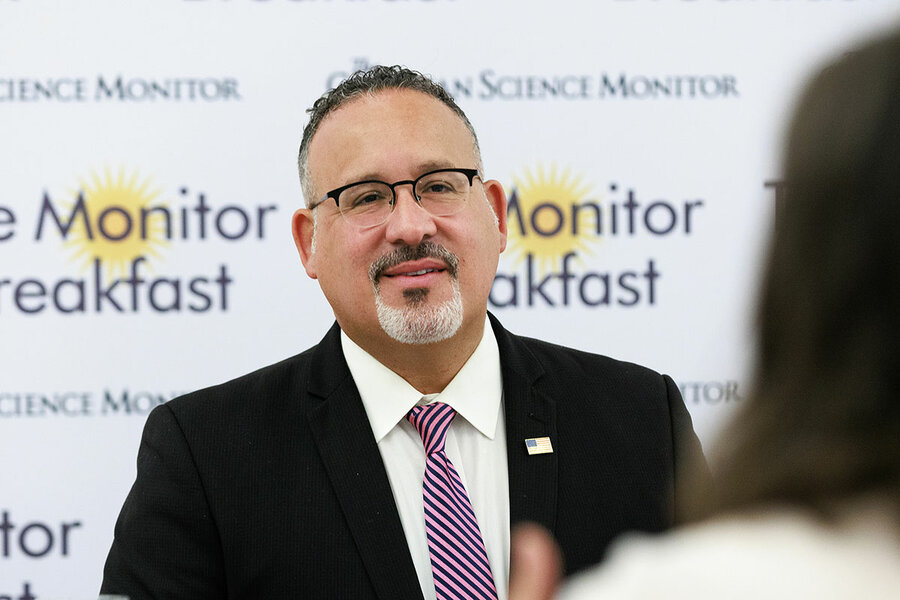Education secretary: America’s higher education system is ‘broken’
Loading...
| Washington
America’s education landscape can feel like a battlefield with wars being waged over reading, cultural issues, school funding, and college admission processes.
But at a breakfast with reporters hosted by The Christian Science Monitor on Wednesday, Education Secretary Miguel Cardona emphasized the need for a level playing field as students from all walks of life move from early childhood programs through college or apprenticeship training. Calling out the latter, he says the nation has a “broken higher education system.”
Runaway costs, he says, have saddled too many people with student loan debt or prevented them from stepping foot into a college or university altogether.
Why We Wrote This
Between falling test scores in K-12 and rising debt for college students, the challenges facing the U.S. education system this school year are profound. Education Secretary Miguel Cardona weighs in on the current landscape.
The Supreme Court, however, struck down President Joe Biden’s student loan forgiveness plan in June, which would have forgiven up to $20,000 in debt for those who make less than $125,000 a year. The administration, in turn, debuted the Saving on a Valuable Education (SAVE) plan, which adjusts loan payments based on income and family size and offers forgiveness after certain timespans.
“We’re banking on the fact that if we open doors to higher education, not only are our families going to be better, but our country is going to be better,” Dr. Cardona says.
The nation’s top education official also took aim at what he describes as “targeted attacks” against LGBTQ+ students and students of color through curriculum changes, book bans, and other efforts to stymie diverse points of view in the classroom. Dr. Cardona says that his department’s Office for Civil Rights will be investigating claims related to alleged hostile learning environments or civil rights violations.
Though he acknowledges the federal government’s role in school-based instructional decisions is limited, Dr. Cardona says he won’t be silent as an educator or a father.
“You’re more likely to find the protagonist of a book being a puppy than a Latino in this country,” he says. “What message does that send to my kids?”
As a new academic year gets underway – with stubborn pandemic-era challenges and an election year around the corner – here’s more of what Dr. Cardona had to say during the Monitor Breakfast. Excerpts have been lightly edited for clarity.
College enrollment hasn’t recovered since the pandemic. At the same time, members of Generation Z have shown less interest in pursuing higher education. How is your department tackling those dual challenges?
We have to evolve our thinking to make sure that our students have pathways. And when you graduate with a credential from a high school or from a two-year college, where you don’t have $100,000 in debt, it doesn’t mean you’re done. It means you can go into the workforce, make $75,000, make $80,000, continue [and] get an advanced degree.
Oftentimes, it’s the company that’s paying for your higher education now, and then [you] make a really good salary on something that you love.
We have to make it more accessible, more affordable, and we have to show the return on investment in a four-year degree. And I’m challenging higher-ed, four-year institutions to get to the table, too, to show that value.
With critically low literacy skills among students, there’s a shift underway toward the phonics-based “science of reading” approach. Will the federal government back those reforms through funding choices?
We certainly want to support states and districts that are using evidence-based practices, and that’s a requirement, but we fall short of requiring a specific curricular program.
If the program is an evidence-based program that has evidence to show that it works, it would be something that we would consider supporting. And that’s where I want to be careful not to single out any one particular program over another. They have to be evidence-based. What’s the evidence that it works? Programs that have phonics, phonemic awareness, oral fluency – those are evidence-based.
Does the newly unveiled SAVE program encourage people to take out loans that are unaffordable and, eventually, will become the burden of taxpayers?
We are opening doors to higher education to people that would otherwise feel like it’s not available to them. It’s making higher education more accessible to more people and also informing them – better than we have in the past – of what fields are needed and which institutions provide you a better return on investment.
We’re going to have students making better decisions about which programs they want to go into. No one goes into it saying, “I’m going into this program because in 20 years, I’m going to have my debt relieved.” They go into it because they want to make good money.
Spending deadlines are approaching for the avalanche of federal funds given to schools during the pandemic. Are any additional federal investments on the horizon?
The federal government pays about 9% of education budgets. So we need to see an increase in the other 91% to maintain some of the strategies that we know work. I always tell governors, I tell state leaders, I tell local leaders – with education, just match the urgency of the president.
How do states and local governments come up with that money?
I think we have to recognize that [it’s] pay now or pay later. You either invest in education, or you deal with the symptoms of underinvestment. As a country, we’ve normalized the symptoms of underinvestment.
To me, it’s really communicating the message that we are in this together and that it is a shared investment in our future.






